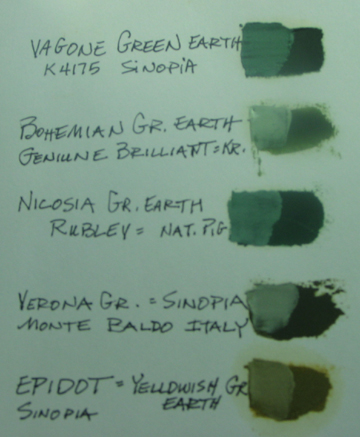Some of the most useful colors I have found for this project are the lovely green earths. Green earth is a generic term used to describe a family of colors. Verona green, (mined near Verona, Italy), epidot, Bavarian and Bohemian, nicosia, celadonite, terre verde, and vagone are a few.
For the most part, each one is slightly gritty. These natural siliceous mineral pigments have very low (weak) covering and tinting strength. Most, also, have a greyish-green cast that becomes very apparent after mixed with white.
pigments have very low (weak) covering and tinting strength. Most, also, have a greyish-green cast that becomes very apparent after mixed with white.
I have discovered great results from experimentation with these pigments. Often, in my past experience, while making, say……a muted background color, I would need to mix 3 or 4 modern pigments to achieve just the correct tone. Using historic pigments presents an entirely different thought process because fewer colors are necessary. By using one of the green earths which naturally is muted, along with a burnt or raw umber and perhaps a flyspeck of Naples yellow for added translucency, the background tones are easily made. Using only 2 pigments plus a bit of 1 more, and you are there.
Celadon has a rich history full of myths and legends, mostly from the Chinese and Turkish cultures. This pigment has been widely used in glazes for porcelain and pottery since antiquity. According to Victoria Findlay in her book Color; A Natural History of the Palette, celadon was for centuries thought to have secret, almost magical powers, especially in China. If jars glazed with celadon had a clear pleasing tone when struck, people would consider the jars as homes of gods.
Another colorful story is about jars owned by the Sultan in Borneo. He believed the jars had powers of prophecy. One jar "howled dolefully" on the night before the Sultan's wife died. Many many similar legends can be found about this coveted green pigment.
This is one color I have yet to try, but when I do perhaps I will create my own legends.

Create your own legends? I love it! And I want a jar lined in celadon. That sounds like a perfect ancillary product line. 🙂
Of course, I’m terribly partial to green hues.
Thank you for sharing your thought process with others — a brave feat, since so many artists are secretive with their methods. If you believe that the creative well is never empty (and I believe you do), then disclosure can only lead to further discoveries!